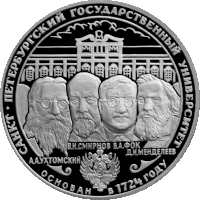Vladimir Ivanovich Smirnov | |
|---|---|
 Vladimir Smirnov (2nd from left) on a Russian commemorative coin (1999). | |
| Born | 10 June 1887 |
| Died | 11 February 1974 (aged 86) |
| Nationality (legal) | Russian |
| Alma mater | St. Petersburg State University |
| Scientific career | |
| Fields | Mathematics |
| Institutions | St. Petersburg State University |
| Doctoral advisor | Vladimir Steklov |
| Doctoral students | Leonid Kantorovich Solomon Mikhlin Sergei Sobolev |
Vladimir Ivanovich Smirnov (Russian: Влади́мир Ива́нович Смирно́в) (10 June 1887 – 11 February 1974) was a mathematician who made significant contributions in both pure and applied mathematics, and also in the history of mathematics.
Smirnov worked on diverse areas of mathematics, such as complex functions and conjugate functions in Euclidean spaces. In the applied field his work includes the propagation of waves in elastic media with plane boundaries (with Sergei Sobolev) and the oscillations of elastic spheres. His pioneering approach to solving the initial-boundary value problem to the wave equation[1] formed the basis of the spacetime triangle diagram (STTD) technique[2] for wave motion developed by his follower Victor Borisov (also known as the Smirnov method of incomplete separation of variables[3][4][5]).
Smirnov was a Ph.D. student of Vladimir Steklov. Among his notable students were Sergei Sobolev, Solomon Mikhlin and Nobel prize winner Leonid Kantorovich.

Smirnov is also widely known among students for his five volume series (in seven books) A Course in Higher Mathematics (Курс высшей математики) (the first volume was written jointly with Jacob Tamarkin).
YouTube Encyclopedic
-
1/3Views:5372 005408
-
Stanislav Smirnov - Ising model
-
PRIMA2009 Plenary Lecture 2: Stanislav Smirnov (Uni of Geneva)
-
TEDxSkolkovo - Andrey Nikolayev - Mathematical studies: a new form of tradition
Transcription
References
- ^ Smirnov, Vladimir Ivanovich (1937), The solution to a problem with limits for the equation of waves in the case of the circle and the sphere., vol. 14, Dokl. Akad. Nauk SSSR [Comptes Rendus de l'Académie des Sciences de l'URSS], pp. 13–16
- ^ Hernández-Figueroa, Hugo E.; Recami, Erasmo; Zamboni-Rached, Michel, eds. (2013). Non-diffracting Waves. Berlin, Germany: Wiley-VCH. pp. 287–306. ISBN 978-3-527-41195-5.
- ^ Borisov, Victor Vasil'evich (1987). Nonsteady-State Electromagnetic Waves. Leningrad: Leningrad State University Press.
- ^ Borisov, Victor Vasil'evich (1996). Electromagnetic Fields of Transient Currents. Leningrad State University Press.
- ^ Borisov, Victor Vasil'evich; Utkin, A. B. (1995). "The transient electromagnetic field produced by a moving pulse of line current". Journal of Physics D: Applied Physics. 28 (4): 614–622. Bibcode:1995JPhD...28..614B. doi:10.1088/0022-3727/28/4/003. S2CID 250812545.
External links
- Vladimir Smirnov at the Mathematics Genealogy Project
- O'Connor, John J.; Robertson, Edmund F., "Vladimir Smirnov", MacTutor History of Mathematics Archive, University of St Andrews
